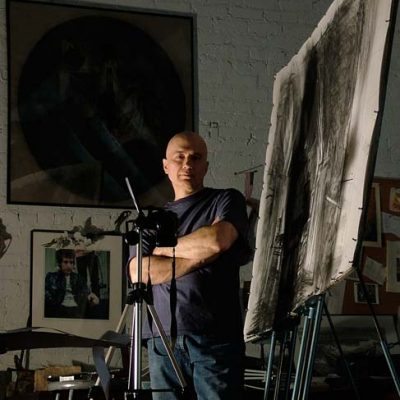Artist Bill Murphy’s mood-evoking works describe the beauty and “lighter” side of decay and transformation
by Regina Molaro
Through his art work, he’s captured many moments in time—from the destruction on the North Shore waterfront after Hurricane Sandy to the simplicity of a glorious sunflower that has fallen from its vine.
Artist Bill Murphy, a Staten Island native, uses the urlaburninglight.com for his work. The inspiration came from a blues song by Blind Willie Johnson. Its lyrics say, in part, “Well I read the Bible often and I tried to read it right. As far as I can understand, it’s nothing but a burning light.”
Because of the importance light plays in his work, that idea resonates with Murphy.
“I like the imagery, and light has a lot of effect on my work. ‘Nothing but a burning light’ is quite an understatement,” he said.
Far from the shores of the borough, Murphy’s work has been exhibited at The British Museum in London, the Danforth Art Museum in Massachusetts, and the National Baseball Hall of Fame in Cooperstown, NY. Subject matter varies from Manhattan cityscapes to empty saloons, forgotten graveyards, and reclining nudes. Recently landscapes have been the focus of his artist’s eye, but in the past, he has spent long periods creating portraits, figures, and interiors.
When viewing his work, one easily recognizes the beauty of decay and transformation. “Decay occurs naturally in the passage of time. Everything we know or can see decays and then is born again in a new form; there is no destruction, only transformation. And from a formal viewpoint, decay is very beautiful for the artist—it contains wonderful textures and colors,” said Murphy.
From etchings and lithographs to drawings and paintings, the work spans multiple mediums. “Like a patriarch of a large family, I can say I love them all or hate them all—depending. The good thing about working this way is that it rejuvenates my interest,” said the artist.
That diversity may not always be in his best commercial interests. Murphy explained that, from a commercial viewpoint, those who work on a variety of subjects and in a variety of mediums may be limited in the gallery world, since they’re not producing an easily recognizable “commodity” for gallery owners to recognize or identify them by.
Acting without an agent, Murphy represents himself and trusts a select group of galleries for display, including The Old Print Shop Gallery in Manhattan and the Temperance Tavern Fine Arts in New Hampshire.
He credits his friend Brett Busang—a painter and writer—for placing his artwork in the Permanent Collection at the Library of Congress in Washington D.C., including the etchings “Eulogy for Kreischerville” and “From Silver Lake.” The former was Murphy’s first attempt to depict the derelict shipyard surrounding the abandoned brick factory in Kreischerville, Staten Island, while “From Silver Lake” depicts a view not far from Murphy’s home. (The scene is from atop a hill looking toward Manhattan as it was seen in the pre-9/11 days.)
“In different ways, ‘From Silver Lake’ and ‘Eulogy for Kreischerville’ represent flip sides of contemporary Staten Island life,” said Murphy. Vision and talent have helped put this Islander into the spotlight, but having local roots also helped.
“I’m the Staten Island guy. Whenever anyone needs an image of Staten Island, they seem to call me,” he laughed. That’s how the British Museum acquired a portfolio of work that commemorated the 150th anniversary of the consolidation of the five boroughs of New York City. Commissioned by The Old Print Shop, the portfolio of city prints were of historical importance. (It’s important to note that the British Museum acquires very little contemporary work.
Early Inspiration
A favorite expression the artist refers to one is courtesy of artist Chuck Close, who once observed that, “Inspiration is for amateurs.”
“It’s a favorite quote because I totally disagree with it, actually. Without inspiration, I am nothing,” said Murphy. One of his biggest influences of his childhood was artwork found in comic books, for example. A fan of Marvel, Murphy recalls purchasing his first Spider-Man and Fantastic Four in a candy store, and Steve Ditko and Jack Kirby—both early Marvel artists—were deeply influential.
Of course, there were are also “the greats,” such as Vermeer, Degas, Rembrandt, and Edward Hopper, though Murphy revealed that Whistler’s etchings are the only works he ever consciously emulated. American artists Andrew Wyeth and Edwin Dickinson were also informative.
Beyond being voted the Best Visual Artist in the borough in Staten Island Advance’s Readers Choice Awards poll in 2007, Murphy was given three “original works” grants by the Council on the Arts and Humanities for Staten Island.
Looking back, it seems being an artist was inevitable. According to his mother, Murphy could draw before he could speak, and artwork quickly became a pivotal means of self-expression.
Eliminating career paths such as law and medicine, he chose to explore illustration, and attended Brooklyn College and the School of Visual Arts, where he earned a Bachelor of Fine Arts. He also enrolled in The Art Students League and attended Vermont College, where he earned a Master of Fine Arts.
Although he set his sights on being an illustrator, Murphy eventually decided that this profession wasn’t his calling.
“I could draw well enough, but hated the deadlines and someone telling me exactly what to draw,” he recalled.
At the School of Visual Arts, Murphy met many artists who still mean a great deal to him, including Marshall Arisman, Herb Katzman, and Jim Kearns, as well as Louise Bourgeois—the last a prolific painter and installation artist.
Recent Work
New shows include an exhibit of 10 pieces that just opened in Syracuse, NY, and which will be traveling to the Kalamazoo Institute of Fine Arts in Michigan. In May, he’ll be part of an exhibition called “99 Drawings” at Wagner College (where the artist has taught since 1984). “It will be a survey of what I feel is my best work,” he said.
He has also worked on the New York Wheel—a 630-foot tall Ferris wheel, which is being built on the North Shore.
What advice does Murphy have for aspiring artists?
“I love this quote by Bruce Springsteen,” he offered. “‘If you can leave it, you should.’ You had better want it real bad because, if not, there are a lot of people who do.”








